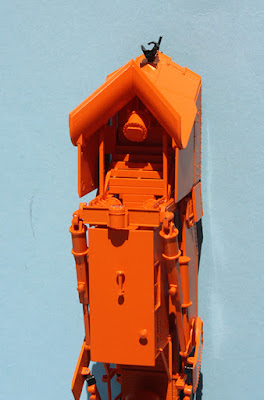I have been intrigued by Jordan spreaders since I was a boy, and saw a spreader being worked on by a mechanic. Not sure where this happened, maybe near the Southern Pacific’s Burbank, California depot, and I had no idea what this complex machine was. But others who knew railroading explained it to me, and I find them interesting to this day.
Today we have a phenomenal amount of information about SP spreaders, because of Ken Harrison’s magnificent opus on a wider topic, Southern Pacific Maintenance of Way Equipment, published by the SP Historical & Technical Society in 2022. (You can read my review of the book at: https://modelingthesp.blogspot.com/2023/02/ken-harrisons-marvelous-addition-to-sp.html .) Ken devotes the entirety of his Chapter 2 to spreaders, and my knowledge of SP’s machines largely stems from this chapter.
Photos of spreaders at work aren’t common (aside from snow removal, which doesn’t occur on my layout), so I was delighted to find the photo below in Ken’s book. It was taken at Seacliff, California (on the Santa Cruz Branch) on March 19, 1978 by Gary G. Allen, from the John Shaw collection. One side of the spreader is re-contouring the trackside area.
Manufactured for many years by the O.F. Jordan Company (thus their name) in East Chicago, Indiana, spreaders came in quite a few variations and several sizes. SP owned many of the variations. I have long thought that my layout needed to host a Jordan spreader somewhere, and in fact the layout does include what SP called an “outfit track,” used to host or merely to store work outfits, comprising all kinds of work cars.
But this idea of including a spreader has remained dormant for years. I have occasionally been tempted by brass models of Jordan spreaders, though the cost is substantial, and the Walthers plastic HO model seemed too modern. But aha! Looking into Ken’s book, I understand better what I am looking at. The most important point to recognize is that Jordan’s product didn’t change that much over the years, the most visible aspect being where the cab was located, and how big it was. Let’s have another look at the Walthers model, in its recent assembled incarnation (there was a kit in the 1990s).
A side view shows the vivid orange color (SP was just beginning to use this color for spreaders, in place of the traditional boxcar red, in the 1950s) and the probably arbitrary number, SP MW 4000. In a 1956 SP MW roster, car 4000 was a boarding bunk car. There were a number of spreaders with higher 4000-series numbers, so this is at least in the ballpark. I’ll change it.
What is immediately striking about the model is the very high plow in front. I cannot find that SP ever bought a Jordan spreader like this, certainly not in the 1950s, which I model. Instead, the SP ones with a sort of centered cab location like the model, had a far smaller size of front plow or faceplate.
I’ll illustrate with a photo from the book, a Jordan builder photo of SP MW 4066 from 1953 (John Shaw collection). This spreader is a lot like the Walthers model, except for the front shape, at left. Note also that the paint is boxcar red. Trucks have solid bearings, not roller bearings like the Walthers model.
Could I just cut down the Walthers front plow? Luckily, the detail inside the plow is included, including the front steps descending from the cab, and the pneumatic cylinder that is prominent in the photo above. Here’s how it looks:
I soon realized that the low front configuration of SP spreader 4066, shown in the prototype photo above, is in fact molded on the Walthers model along the bottom of the front end, but with a great deal of higher material added at sides and front. My first step in seeing if it could be modified, was to remove the front structure entirely. By removing the front coupler, this can be wiggled free. Here’s the front view at this point.
Tony Thompson





Custom Finishing offers a "low plow' conversion kit, # 317, for the Walther's Jordan plow, might not be as high as SP pictured
ReplyDelete